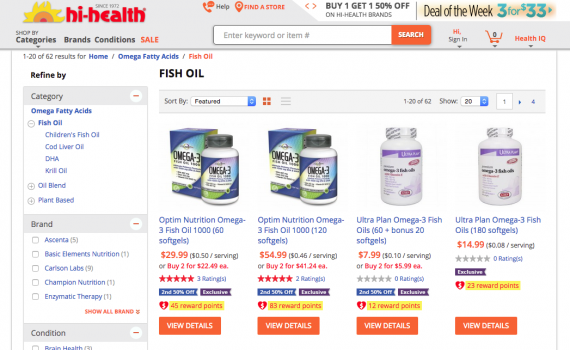Editor’s Note: Meet Jill Kocher at Ignite 2015, our conference on Sept. 16 and 17 in Dallas, where she’ll present two sessions: “The Essential SEO Checklist for Ecommerce Companies, for 2015†and “Keyword Research for SEO Success: How Do Consumers Search for Your Brand and Products?â€
Every so often an ecommerce business is brave enough to raise its hand for a public review of its search engine optimization performance. Hi-Health, a retailer of nutritional products, is today’s brave business.
Hi-Health is doubly interesting for SEO because it boasts brick-and-mortar stores as well as a large ecommerce offering. Both areas can be leveraged to enhance Hi-Health’s SEO performance and drive shoppers into stores as well as online.
This week I’ll focus on Hi-Health’s ecommerce potential. Next week I’ll detail how SEO can improve Hi-Health’s ability to drive customers into its physical stores.
Hi-Health sells nutritional products online and through physical stores.
SEO Navigation Analysis
On the ecommerce front, www.hihealth.com has a lot going for it. It’s architecturally strong for SEO in that the navigation includes the three different ways people search for health products: by type, by brand, and by medical condition.
For instance, a consumer might look for omega fatty acids by type (such as “fish oilâ€), by a preferred brand (like “Carson Labsâ€), or by medical condition (such as “joint health or painâ€). Hi-Health has all three bases covered navigationally — I addressed the importance of navigation for SEO in “Header Navigation Critical to Success,†my article last week.
As a result, Hi-Health also has the three main ways that consumers will search in a search engine for its products. Clearly someone at Hi-Health has done keyword research to identify how people search, and then merged that with market research outlining how customers identify and shop for their products.
While the navigation is entirely accessible to search engines – an area I still find issues with in many sites – Hi-Health does have some SEO issues with its navigational filters. None of the filters (such as brand, condition, or ingredient) are optimizable independently from the parent category or subcategory page.
For example, the page for omega fatty acids + fish oil + joint support has exactly the same title tag, meta description, and H1 heading as its parent page, omega fatty acids + fish oil. The products displayed have changed, but the textual signals that search engines use to determine the relevance of the page have not changed. This makes it much harder for Hi-Health to rank for any of its filtered category pages, essentially cutting off part of its long tail of search traffic.
SEO Title Tag Analysis
Speaking of title tags, these could be improved as well. Most of the title tags I observed begin with “Best Priced†or “Best Value.†While this may be true, it pushes the keywords for which Hi-Health wants to rank later in the title tag. This may seem like too small an issue to worry about, but the first words in the title tag send the strongest signal.
For example, the Fish Oil page mentioned earlier in the Omega Fatty Acids category has a title tag of “Best Priced Fish Oil – Omega Fatty Acids products everyday at hihealth.com.†According to my keyword research, the phrase “best priced fish oil†is not searched for in numbers large enough to show in the Google Keyword Tool. Right there Hi-Health has an opportunity to optimize.
The Fish Oil page within the Omega Fatty Acids category could benefit from using a title tag with the keywords up front.
Changing the title tag to “Fish Oil Supplements: Omega Fatty Acids, Best Prices | Hi-Health†puts the most valuable keywords first, makes it easier for consumers to instantly see in the search results what the page is about, and removes 10 superfluous characters from the title tag. Where “best priced fish oil†drove no Google searches, “fish oil supplements†drives 8,100 searches per month on average in the U.S. It also retains the phrase “omega fatty acids†to lend contextual support.
This change could be made formulaically in the category template to impact all of the title tags for the pages using that template at once. Essentially the formula would be:
{Page Name} Supplements: {Category Name}, Best Prices | Hi-Health
In addition, the formulas for all of the other templates should be reviewed or created as well with this same concept in mind. I recommend keeping the brand appendage — “ | Hi-Health†— the same in every template for consistency across the site.
A formula only gets you so far, naturally. Starting with the pages that represent the greatest organic search value based on keyword research, manually optimize the title tags to improve upon the formula.
SEO Home Page Analysis
As with many home pages, Hi-Health’s is primarily images and links to other pages. There’s nothing to state what Hi-Health stands for.
The home page needs a section of permanent text and a permanent headline that anchors the keyword theme of the page. Without this, the keyword theme of the site changes as features and promotions are introduced onto the site and removed. It doesn’t have to be huge, just a couple of sentences. It doesn’t have to be the first thing that visitors see, but they do have to be able to see it on the page, above the footer.
Product Page Analysis
Hi-Health’s product pages are done very well with lots of good textual content. Even the nutritional information, which is typically relegated to a single image that’s unreadable to search engine crawlers, is presented in textual form.
Hi-Health’s product pages contain good textual content, as shown on this page for Optim Nutrition Omega-3 Fish Oil.
Hi-Health has also implemented structured data for breadcrumbs, ratings, product pricing, and product availability. When they show up in the product rankings, the search engines may choose to augment their search result with this data.
The product ratings feature is interesting because it stands alone, with no reviews feature offered. Product reviews would enable customers’ comments to add relevant user generated content to boost the keyword themes of the product pages. Adding reviews would be a boon for SEO.
Other SEO Items
Hi-Health uses a “Site Map†(linked to from the footer) to ostensibly boost SEO. I’m not a fan of this tactic. It’s not much better than having a complete XML site map, which you really should have anyway. Both forms of site map just foster indexation as opposed to boosting actual rankings.
If you need an SEO site map, then what you really need is to fix the architecture and navigation on your site to enable search engine crawlers to access content in an optimal way.
Since Hi-Health appears to already have a strong and crawlable architecture and navigation, the SEO site map is redundant. In addition, the SEO site map is out of date, with links to past promotions that display either blank pages or content that is no longer relevant.
Hi-Health also makes use of a good amount of related content in the form of a blog, expert advice, videos, guides, and more. From the outside, I can’t find any indication that this content is driving organic search traffic. I’d need access to Hi-Health’s analytics to truly analyze this, but my outside data sources don’t show any substantial traffic drivers beyond the home page and the store locator.
When you have good content that isn’t working hard for your organic search, it’s time for a look at your content marketing plan. Search engines want to see outside links, mentions, and shares before they consider content authoritative enough to rank, especially content that is heavily branded and at least half dedicated to selling products. It may be necessary for Hi-Health to dial back the amount of sales-oriented content and increase the amount of informational content in each piece to increase chances of ranking.
This analysis is understandably done at a high level, but these are the biggest opportunities I see with a quick review. If you’d like to submit your site for a similar review, please contact me at jill@practicalecommerce.com.



